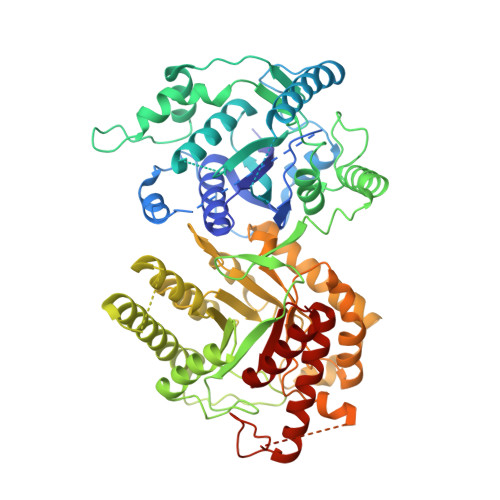Structure of 6-hydroxymethyl-7,8-dihydropterin pyrophosphokinase-dihydropteroate synthase fromPlasmodium vivaxsheds light on drug resistance
Yogavel, M., Nettleship, J.E., Sharma, A., Harlos, K., Jamwal, A., Chaturvedi, R., Sharma, M., Jain, V., Chhibber-Goel, J., Sharma, A.(2018) J Biol Chem 293: 14962-14972
- PubMed: 30104413
- DOI: https://doi.org/10.1074/jbc.RA118.004558
- Primary Citation of Related Structures:
5Z79 - PubMed Abstract:
The genomes of the malaria-causing Plasmodium parasites encode a protein fused of 6-hydroxymethyl-7,8-dihydropterin pyrophosphokinase (HPPK) and dihydropteroate synthase (DHPS) domains that catalyze sequential reactions in the folate biosynthetic pathway. Whereas higher organisms derive folate from their diet and lack the enzymes for its synthesis, most eubacteria and a number of lower eukaryotes including malaria parasites synthesize tetrahydrofolate via DHPS. Plasmodium falciparum ( Pf ) and Plasmodium vivax ( Pv ) HPPK-DHPSs are currently targets of drugs like sulfadoxine (SDX). The SDX effectiveness as an antimalarial drug is increasingly diminished by the rise and spread of drug-resistant mutations. Here, we present the crystal structure of Pv HPPK-DHPS in complex with four substrates/analogs, revealing the bifunctional Pv HPPK-DHPS architecture in an unprecedented state of enzymatic activation. SDX's effect on HPPK-DHPS is due to 4-amino benzoic acid ( p ABA) mimicry, and the Pv HPPK-DHPS structure sheds light on the SDX-binding cavity, as well as on mutations that effect SDX potency. We mapped five dominant drug resistance mutations in Pv HPPK-DHPS: S382A, A383G, K512E/D, A553G, and V585A, most of which occur individually or in clusters proximal to the p ABA-binding site. We found that these resistance mutations subtly alter the intricate enzyme/ p ABA/SDX interactions such that DHPS affinity for p ABA is diminished only moderately, but its affinity for SDX is changed substantially. In conclusion, the Pv HPPK-DHPS structure rationalizes and unravels the structural bases for SDX resistance mutations and highlights architectural features in HPPK-DHPSs from malaria parasites that can form the basis for developing next-generation anti-folate agents to combat malaria parasites.
Organizational Affiliation:
From the Molecular Medicine-Structural Parasitology Group, International Centre for Genetic Engineering and Biotechnology, New Delhi 110067, India, myogavel@gmail.com.




















